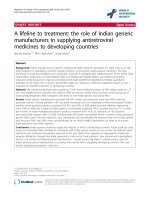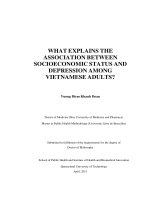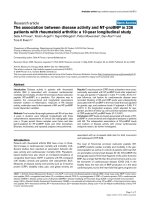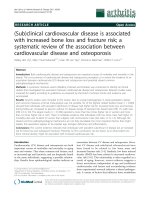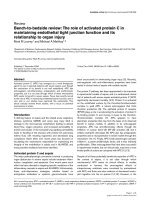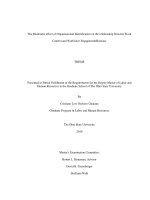Assessing the role of family well-being on the quality of life of Indian children with thalassemia
Bạn đang xem bản rút gọn của tài liệu. Xem và tải ngay bản đầy đủ của tài liệu tại đây (667.26 KB, 6 trang )
Thiyagarajan et al. BMC Pediatrics
(2019) 19:100
/>
RESEARCH ARTICLE
Open Access
Assessing the role of family well-being on
the quality of life of Indian children with
thalassemia
Arulmani Thiyagarajan* , Bagavandas M and Kalpana Kosalram
Abstract
Background: The association between chronic diseases and psychological problems is well established. As thalassemia
is chronic blood disorder with burdensome treatment procedures, patients are likely to have psychological health
problems. Many studies reported evidences regarding the quality of life. But, factors influencing the health-related quality
of life with focus on psychological well-being were minimally studied. We aimed to find the factors contributing to the
health-related quality of life among thalassemia affected children and hypothesising whether the parent’s psychological
well-being, sociodemographic characteristics and transfusion interval have an impact on children’s quality of life.
Method: A cross-sectional analytical study conducted on 125 thalassemia patients and 125 parents (either father or
mother) referred to the clinic of Thalassemia treatment center. KIDSCREEN-10 and Ryff Psychological well-being scale is
used for measuring the health-related quality of life and well-being of children and parent respectively.
Results: We have found the three factors such as family income, children education, and, parent education significantly
contributed to the children’s health-related quality of life among thalassemia affected children. The average score of
Health-related quality of life among children is 16.28 with a standard deviation of 3.432 and the mean psychological
well-being score for the parent is 83.99 with a standard deviation of 11.41. A positive correlation exists between parent
psychological well-being and children’s health-related quality of life.
Conclusion: Family well-being is the foundation for quality of life of the children. It was found that factors such as family
income and parents’ and children’s education have a direct association with HRQoL of life of children with thalassemia.
However, more studies need to be done in order to ascertain the factors contributing to HRQoL of children with
thalassemia to improve the quality of life of thalassemia patients.
Keywords: Health-related quality of life, Thalassemia, Psychological well-being, Family income, Parent’s education
Background
Study of the relationship between disease and the sense of
emotion has always been an interesting area of research.
The associations between chronic disease conditions and
psychological problems is well established [1, 2]. the topics
of psychology and concentration of well-being have grown
popular in ambit of public policy [3, 4]. This has led to an
interest in a less researched aspect of the relationship between emotion and disease, namely, the impact of disease
condition and well-being.
Thalassemia is a chronic disorder. It is a life-threatening
and life-limiting condition that affects the patient clinically
* Correspondence:
School of Public Health, SRM University, Chennai, India
and psychologically by its burdensome treatment process:
regular blood transfusions, iron chelation, frequent
hospitalization and medical follow-up [5]. Globally, the
prevalence of thalassemia ranges between 2 and 25% [6].
For every 100,000 live births, approximately 4.4 children
are affected by thalassemia throughout the world [7]. Disease burden also increases because of repeated visits to
the hospital, repeated laboratory tests and frequent monitoring of symptoms in detecting complications [8]. The
paucity of healthcare policies, inadequate treatment support and lack of regular screening contribute to an increase in vulnerability to the disease. India likely to have a
higher burden as there are no health policies or preventive
checks like in other countries (Cyprus, Iran, Pakistan,
© The Author(s). 2019 Open Access This article is distributed under the terms of the Creative Commons Attribution 4.0
International License ( which permits unrestricted use, distribution, and
reproduction in any medium, provided you give appropriate credit to the original author(s) and the source, provide a link to
the Creative Commons license, and indicate if changes were made. The Creative Commons Public Domain Dedication waiver
( applies to the data made available in this article, unless otherwise stated.
Thiyagarajan et al. BMC Pediatrics
(2019) 19:100
Palestine territories) [9, 10]. Every year, 10,000 children
are born with thalassemia, which approximately accounts
for 10% of the world’s total incidence of thalassemia and
one in eight of thalassemia patients’ lives in India [11].
Majority of thalassemia patients suffer from depressive
symptoms and mental disorders [12–14]. Children, teenagers, and families that have patients with thalassemia
are more susceptible to facing emotional and behavioral
problems. The burden of thalassemia challenges the entire family at physical, cognitive, and emotional levels
and disrupts their life as a whole [15]. The recurring and
complex treatment procedure often places undue psychological and financial burden on the individual and
the family.
Researchers have documented the status of well-being,
health-related quality of life and burden in families that
have children with thalassemia. There is lack of evidence
in regard to factors contributing to their quality of life.
For improving the quality of life of thalassemia patients,
it is imperative to understand the factors that contribute
to it.
In this research, we aim to assess the factors influencing the health-related quality of life and also hypothesise whether the parent’s psychological well-being has
an impact on children’s quality of life. It could possibly
pave the way to understand the area that needs to be
focused upon for improving the quality of life among
thalassemia patients.
Objectives
1. To assess the factors influencing the health-related
quality of life.
2. To hypothesise whether the parent’s psychological
well-being, sociodemographic characteristics and transfusion interval have an impact on children’s quality of life.
Methods
Page 2 of 6
debilitating disorders other than thalassemia major were
excluded from the study. Similarly, 125 parents (either
mother or father) of the children were included in the
study. The sample size was calculated using the formula
.
z2 pq
(95% C. I, Prevalence – 4%, Precision – 6%)
d2
[16]. We performed a complete enumeration of patients
who visited thalassemia treatment centre during our
study period.
Instrument
Kidscreen-10
The KIDSCREEN-10 is a questionnaire developed and
normalised for surveying health-related quality of life
(HRQoL) in children and adolescents. Existing validation
results provided a single- dimensionality HRQoL index
consisting of 10 items, which sufficiently represents the
longer KIDSCREEN profiles [17]. We used three-point
rating scale (0, 1, and 2) with the indicator being the better the score, better the HRQoL.
Ryff psychological well-being scale (RPWBS)
Carol Ryff has conceptualised psychological well-being
through a questionnaire consisting of six dimensions:
autonomy, environmental mastery, personal growth,
positive relations with others, purpose in life,
self-acceptance [18]. Parent’s well-being score is the total
of all the components mentioned. We considered the
Ryff scale to capture the psychological well-being among
parents of thalassemia-affected children, focusing on the
psychological component of well-being as the disease
may have a psychological impact at the family level [19].
Validated versions of the tools were used for data collection. We used three-point rating scale (0,1,2), with the
indicator being better the score, better their well-being.
Study design
A cross-sectional analytical study conducted on 125
thalassemia patients (along with either one of their parents) referred to a thalassemia treatment centre. The
study was conducted from 5 January to 31 July 2017.
Study setting
The treatment center is a Voluntary Health Services,
which has a separate unit for treating thalassemia patients and patients with other blood disorders. It is situated in a very prominent locality in Chennai and has
registered patients from the different parts of India.
Study population and study size
The inclusion criteria for the study were patients who
had transfusion-dependent (major) thalassemia and were
less than 18 years of age. Children suffering from
Variables and data collection, data analysis and statistics
Source of data and collection
Data were collected from the individual parent and children through the questionnaires after getting their approval to participate. Personally identifiable information
like name, and address was not recorded keeping the
data anonymous. Variables collected from the questionnaires include the sociodemographic characteristics, disease features, and questions comprising for HRQoL
among children and questions related to psychological
well-being of parents. We used Microsoft Excel for data
entry and Statistical Package for Social Sciences (SPSS)
version 23 for statistical analysis. Data were double entered and all inconsistencies were resolved using the original data collection sheet.
Thiyagarajan et al. BMC Pediatrics
(2019) 19:100
Statistical analysis
Data were first entered in an Excel sheet and then transferred to the SPSS version 23. On preliminary analysis,
observations containing incomplete questionnaires were
removed and thoroughly checked for errors. Data were
normally distributed. Socio-demographic characteristics,
disease features, and HRQoL components and psychological well-being components were analysed. We used
the t-test to compare the quality of life of male and female children and the well-being of the mother and
father. Pearson correlation coefficient was used to assess
the relationship between scores of HRQoL and psychological well-being scores of parents. Multiple linear regression analysis was performed to assess the factors
contributing to children’s HRQoL.
Ethical considerations
The Institutional Review Board (IRB) and the research
ethics committee of the School of Public Health, SRM
Institute of Science and Technology approved the
study. Due permissions were received from relevant authorities in thalassemia treatment center at Voluntary
Health Services. All the participants in the study were
informed about the study objectives and signed a written informed consent form and were assured of the
confidentiality of their personal information. The participants were also informed that the data obtained
from them would be used for publication. However,
their personal identifiers would be kept anonymous and
confidentiality of their personal records maintained.
Results
On 125 thalassemia-affected children, 68 were boys and
57 were girls. All the children are suffered from
transfusion-dependent thalassemia major. Out of the
study population, 50% of the children needed at least
once a month blood transfusion; 47% needed transfusion
twice a month and 3% required more than twice a
month. Table 1 shows the demographic characteristics
of the study population. The mean age of the children
and parents were 6 years and 26 years, respectively.
Average HRQoL was 16.28 with a standard deviation of
3.432. Out of this, 45% of them had an above average
score (Fig. 1). The mean psychological well-being score
for the parent is 83.99 with a standard deviation of 11.41
(Fig. 2). Two parents had a high well-being score of 114
and 116, which are outliers in the study. Independent
sample t-test showed no significant difference in psychological well-being score among mothers and fathers (t
(125) = − 0.646, p = 0.519). The well-being score of the
parents remains the same irrespective of their gender difference. Similarly, no difference in scores of HRQoL among
male and female children (t (123) = − 0.776, p = 0.969). A
positive correlation was found to exist between parents’
Page 3 of 6
Table 1 Demographic characteristics
Parent
Children
Female
72 (57.6%)
57 (45.6%)
Male
53 (42.4%)
68 (55.4%)
Age (years)
26 ± 4.86
6 ± 3.67
Gender
Educational Level
Illiterate
7 (5.6%)
Secondary school and lower
45 (36%)
Diploma or bachelor of science
55 (44%)
Master of science or higher
18 (14.4%)
Religion
Hindu
34 (27.2%)
Muslim
66 (52.8%)
Christian
25 (20%)
Monthly income (Rs.)
< 5000
73 (58.4%)
5000 to 15,000
42 (33.6%)
> 15,000
10 (8%)
psychological well-being and children’s HRQoL (r = 0.329,
n = 125, p < 0.001).
Multiple regression analysis was used to ascertain the
factors influencing the HRQoL of thalassemia-affected
children. Six predictors accounted for 37% of the variance (R2 = .37, F (11,113) =4.023, p < .01); out of which
three predictors significantly provided information on
children’s HRQoL (Table 2).
Discussion
In the current study, we have found certain factors that
have an influence on the HRQoL thalassemia-affected
children. Among them, a major factor focused in this
study was the parents’ psychological well-being, which
was proved to be significantly associated with children’s
HRQoL. Certain factors like children’s and parent’s education status, and family’s monthly income were found
to have a significant influence on children’s HRQoL.
Education is a key indicator of income, family growth,
sustenance, and well-being. Educated parents bring a
warm and pleasing social climate at home comparing to
non-educated parents [20]. Children with educated parents are more inclined to have educational support,
moral advice, economic background, nutritional support,
assisted in taking right decisions, and help to face a
problem with a positive attitude. Education plays a role
in psychological, emotional, social well-being than the
other aspects of well-being [21]. Health outcomes are
also influenced by education [22]. Education makes a
person have a job; income; fulfillment of needs; better
well-being; better health. Likewise, family income also
Thiyagarajan et al. BMC Pediatrics
(2019) 19:100
Page 4 of 6
Fig. 1 Shows the Health-related Quality of Life score of Children with thalassemia; 16 is the mean score and 50% of children are in the score of
13 to 19
Fig. 2 Shows the psychological well-being score of parents; 84 is the mean score and two outliers (score of 114 and 116) and 50% of parents are
in the score of 77 to 90
Thiyagarajan et al. BMC Pediatrics
(2019) 19:100
Table 2 Factors affecting the health-related quality of life of
children with thalassemia
Predictors
Regression Coefficient
Child’s age
−0.043
Child’s education
1.991*
Transfusion interval
0.003
Educational qualification
1.109*
Monthly income
1.023*
Parent’s well-being
−0.236
*Level of significance at p-value <.05
has a major impact on children’s life [23, 24]. Our results
validate the fact that education and income have a direct
influence on the children’s quality of life [25].
As child ages, his or her maturity level and
self-satisfaction also increase. However, in this study, it
was found that children’s age plays no role in predicting
their HRQoL. The frequency of transfusion is dependent
on the severity of the disease condition. But, our study
results suggested that transfusion interval doesn’t influence the children’s quality of life.
Through this study, we found that factors like family
income, education of parents and children may have a
positive influence on the HRQOL of children with thalassemia. Our study also suggests children’s HRQoL has
a positive correlation with the parent’s psychological
well-being. Parent’s well-being (economic, social and
psychological) has even a greater influence on a disabled
child’s health [26]. Children’s quality of life is connected
with parent’s well-being, as the parent remain the main pillar of support to children grow in all aspects [24, 27, 28].
Family well-being is definitely a foundation for children’s
quality of life. Other influencing factors need to be explored
and targeted for improving the quality of life of thalassemia
patients. As this is an observational study, factors associated
with HRQoL are conjectural and should be viewed in that
perspective. More studies to be conducted for validation of
our results.
Strength
This study was carried out in Tamil Nadu, India, where
treatment burden and social stigma are higher for
thalassemia-affected children’s families. This is the first
study to be done, to the best of our knowledge, in India
focusing on the influence on parents’ psychological
well-being on HRQoL of children with thalassemia. This
study was also included participants from different districts of Tamil Nadu registered in the thalassemia treatment center, which makes this study a reflection of the
state as a whole. We have reported study design, sample
selection, data collection, analysis and potential bias as
per the STROBE guidelines. The data were double entered and validated to ensure data quality and to avoid
Page 5 of 6
transcription errors. Globally, many studies had focused
separately on the quality of life of thalassemic children
and psychological issues in caregivers/parents of thalassemic children.
Limitations
There could also be other possible factors influencing
the quality of life of thalassemia affected children and
they need to be studied. A case–control study might be
more appropriate to capture the HRQoL and factors influencing it. However, due to financial and time constraints, authors only focused on the factors described
above. Apart from this, this study could have had the
confounding bias of patients belonging to well-off families as they could access the treatment centre. A section
of lower-socioeconomic status population that has no
access to the treatment centre might have been missed
in the study.
Conclusion
Family well-being is the foundation for the quality of life
of children It was found that factors such as family income and parent’s and children’s education have a direct
association with HRQoL of children with thalassemia.
However, more studies need to be done in order to ascertain the factors contributing to HRQoL of children
affected with thalassemia to improve the quality of life
of thalassemia patients.
Abbreviations
HRQoL: Health-related Quality of Life; IRB: Institutional Review Board;
RPWBS: Ryff Psychological Well-Being Scale; SPSS: Statistical Package for
Social Sciences
Acknowledgments
The authors thank all the study participants. The authors thank School
of Public Health, SRM Institute of Science and Technology for their
esteemed support.
Funding
Not applicable.
Availability of data and materials
The datasets used and analysed during the current study are available from
the corresponding author –
Authors’ contributions
Conceived and designed the experiments: AT, BD and KK. Performed the
experiments: AT. Analyzed the data: AT, BD, KK. Drafted the manuscript: AT
which BD, KK read and revised. All the authors contributed to interpreting
the data and critically revising the manuscript and provided approval of the
final manuscript.
Ethics approval and consent to participate
The Institutional Review Board (IRB) and the research ethics committee of
the School of Public Health, SRM Institute of Science and Technology
approved the study. Due permissions were received from the relevant
authorities of Thalassemia Treatment center. All the participants in the study
were informed about the study objectives and signed a written informed
consent form, and were assured of the confidentiality of their personal
information. Informed consent for participation of children in the study was
obtained from their parents.
Thiyagarajan et al. BMC Pediatrics
(2019) 19:100
Consent for publication
Not applicable.
Competing interests
The authors declare that they have no competing interests.
Publisher’s Note
Springer Nature remains neutral with regard to jurisdictional claims in
published maps and institutional affiliations.
Received: 29 November 2018 Accepted: 22 March 2019
References
1. Marks DF, Murray M, Estacio EV. Health Psychology: Theory, Research and
Practice. SAGE Publications, 2018, fourth edition, p. 463.
2. Michel J-P, Beattie BL, Martin FC, Walston JD, Oxford Textbook of Geriatric
Medicine. Oxford University Press. 3rd edition, 2017, chap. 134, pp. 277–278.
3. Steptoe A, Deaton A, Stone AA. Psychological wellbeing, health and ageing.
Lancet. 2015;385(9968):640–8.
4. Steptoe A, Deaton A, Stone AA. Subjective wellbeing, health, and ageing.
Lancet. 2015;385(9968):640–8.
5. Khurana A, Katyal S, Marwaha RK. Psychosocial burden in thalassemia. The
Indian Journal of Pediatrics. 2006;73(10):877–80.
6. Weatherall DJ, Clegg JB. Inherited haemoglobin disorders: an increasing
global health problem. Bull World Health Organ. 2001;79(8):704–12.
7. Ibrahim Aljeesh Y. Quality of life among thalassemia children patients in the
Gaza strip. American Journal of Nursing Science. 2016;5(3):106.
8. V. P. Choudhry, “Quality of Life in Thalassemia Major,” Indian J. Pediatr. 2018;
85(11)957–958.
9. Cousens NE, Gaff CL, Metcalfe SA, Delatycki MB. Carrier screening for
Beta-thalassaemia: a review of international practice. Eur J Hum Genet.
2010;18(10):1077–83.
10. Verma IC. Burden of genetic disorders in India. Indian J Pediatr. 2000;67(12):893–8.
11. Sengupta M. Thalassemia among the tribal communities of India. Internet J
Biol Anthropol. 2007;1(2):1–9.
12. Moorjani JD, Issac C. Neurotic manifestations in adolescents with
thalassemia major. The Indian Journal of Pediatrics. 2006;73(7):603–7.
13. Messina G, et al. Psychosocial aspects and psychiatric disorders in young
adult with thalassemia major. Intern Emerg Med. 2008;3(4):339–43.
14. L. Mazzone, L. Battaglia, F. Andreozzi, M. A. Romeo, and D. Mazzone,
“Emotional impact in beta-thalassaemia major children following cognitivebehavioural family therapy and quality of life of caregiving mothers,” Clin.
Pract. Epidemiol. Ment. Health CP EMH. 2009;5:5.
15. Tsiantis J, Xypolita-Tsantili D, Papadakou-Lagoyianni S. Family reactions and
their management in a parents group with beta-thalassaemia. Arch Dis
Child. 1982;57(11):860–3.
16. TV SB, Shantaram M. An incidence of β-thalassemia in South India–a review.
Int J. 2016;3(5):1–6.
17. Ravens-Sieberer U, et al. Reliability, construct and criterion validity of the
KIDSCREEN-10 score: a short measure for children and adolescents’ wellbeing and health-related quality of life. Qual Life Res. 2010;19(10):1487–500.
18. Ryff CD. Psychological well-being in adult life. Curr Dir Psychol Sci.
1995;4(4):99–104.
19. Naderi M, reza Hormozi M, Ashrafi M, Emamdadi A. Evaluation of mental
health and related factors among patients with Beta-thalassemia major in
south east of Iran. Iran J Psychiatry. 2012;7(1):47–51.
20. Klebanov PK, Brooks-Gunn J, Duncan GJ. Does neighborhood and family
poverty affect mothers’ parenting, mental health, and social support? J
Marriage Fam. 1994;56(2):441–55.
21. Javed S, Salma J, Khan A. Effect of Education on Quality of Life and Wellbeing. The International Journal of Indian Psychology. 2016;3(3). No. 58.
Available: />22. Virginia Commonwealth University, E. Zimmerman, S. H. Woolf, and Virginia
Commonwealth University, “Understanding the Relationship Between
Education and Health,” NAM Perspect. 2014;4(6).
23. Gariepy G, Elgar FJ, Sentenac M, Barrington-Leigh C. Early-life family income
and subjective well-being in adolescents. PLoS One. 2017;12(7):e0179380.
24. K. Cooper. Does Money Affect Children’s Outcomes?: A Systematic Review.
Joseph Rowntree Foundation. 2013:82–83.
Page 6 of 6
25. Yeung WJ, Linver MR, Brooks-Gunn J. How money matters for young
children’s development: parental investment and family processes. Child
Dev. 2002;73(6):1861–79.
26. Ha J-H, Greenberg JS, Seltzer MM. Parenting a child with a disability:
the role of social support for African American parents. Fam Soc.
2011;92(4):405–11.
27. Flaquer L. Family-related factors influencing child well-being. In: Ben-Arieh
A, Casas F, Frønes I, Korbin JE, editors. Handbook of child well-being:
theories, methods and policies in global perspective. Dordrecht: Springer
Netherlands; 2014. p. 2229–55.
28. Schoon I, Cheng H, Jones E, and Maughan B. Wellbeing of children: Early
influences. London: Institute of Education; 2013, pg. 73. Available: http://
www.nuffieldfoundation.org/well-being-children-early-influences.
